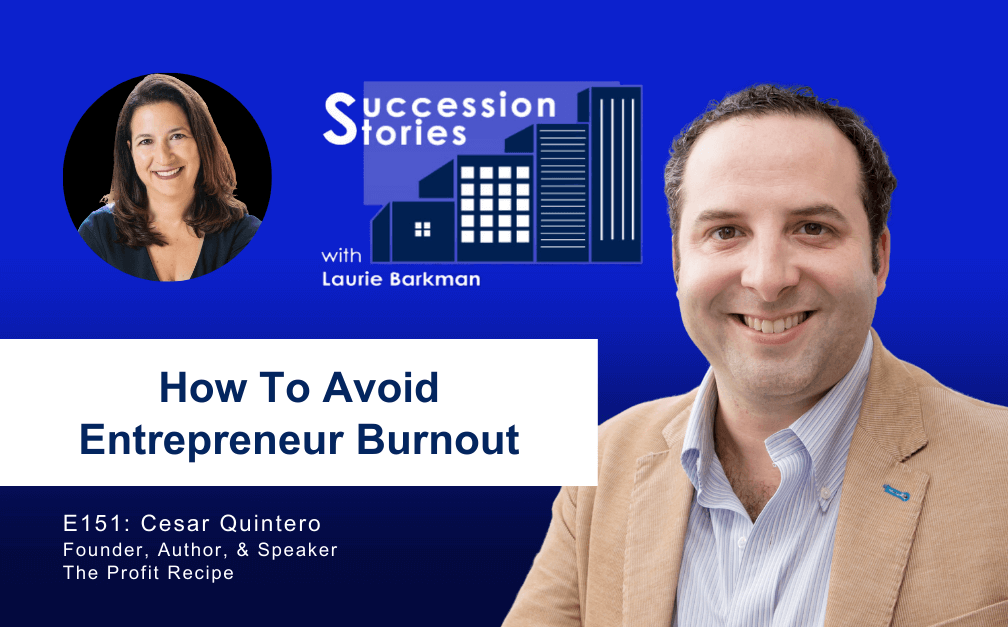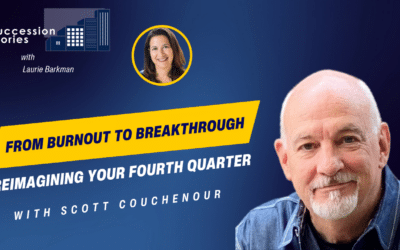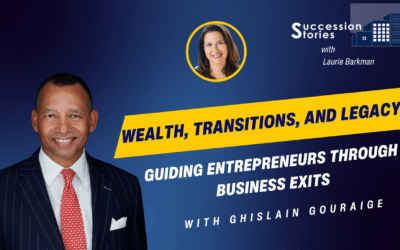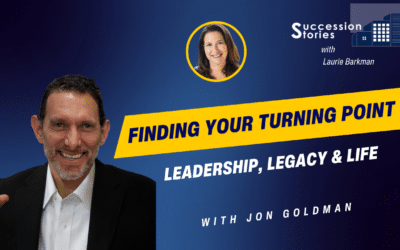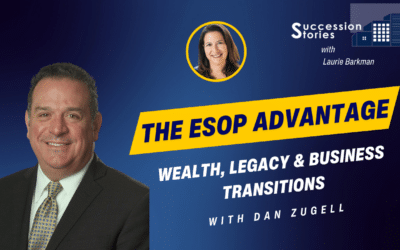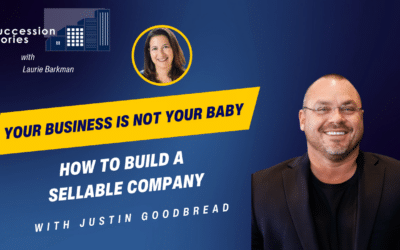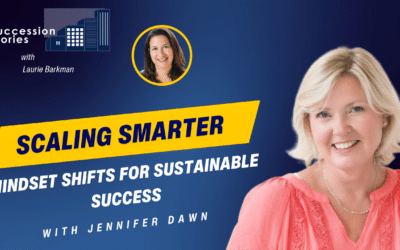Succession Stories host Laurie Barkman, The Business Transition Sherpa™, welcomes Cesar Quintero, a serial entrepreneur in the food service industry.
At age 24, Cesar moved to Miami given the economic turmoil in Venezuela to pursue his dream of starting a business and helping others achieve a healthier lifestyle by founding Fit2Go – the first corporate healthy meal delivery service in Miami.
Nearly 10 years later, he launched two new companies: RawBar2Go, the first licensed food boats in Florida, and The Profit Recipe, a coaching firm empowering entrepreneurs to work ON the business and not IN the business by implementing best practices and the Entrepreneurial Operating System (EOS).
With nearly 50 employees at their peak, and $3.5 million in revenue, Cesar was close to burning out. He resented the business because of the lack of time freedom that he felt.
Listen in as Cesar describes his personal journey of rediscovering the passion for his business. Hear how he bounced back by implementing transformative systems and processes; the open book approach to sharing financials with his team, and eventually selling the business to a team member.
Entrepreneur burnout happens more often than you may realize. 75% of entrepreneurs report occasional or frequent burnout.
Enjoy this Succession Stories episode on how to avoid entrepreneur burnout with Cesar Quintero.
❤️ Show us the love on Rate This Podcast: https://ratethispodcast.com/successionstories
Find Cesar Quintero Here:
Cesar´s Linkedin: https://linkedin.com/in/cesarquintero
Profit recipe website: https://theprofitrecipe.com/
Profit recipe FB: https://www.facebook.com/TheProfitRecipe/
Profit recipe LinkedIn: https://www.linkedin.com/company/the-profit-recipe
_______________________________________
CHECK OUT OUR NEW MASTERCLASS:
“Endgame Entrepreneurship: Build With The Exit In Mind”
Learn how to maximize value and exit on your terms!
_______________________________________
Embark on a journey of understanding and practical application as we navigate ways to avoid entrepreneur burnout, unveiling the potential for growth and empowerment. Unlock deeper insights into the transformative realm of entrepreneurship and scalability by engaging with us through various social media platforms:
My Links:
🌐 Website: https://TheBusinessTransitionSherpa.com
⏰️ Meet With Laurie: https://thebusinesstransitionsherpa.com/connect/
🎙 Podcast: https://podfollow.com/succession-stories
🎥 YouTube: https://www.youtube.com/@TheBusinessTransitionSherpa
😎 Instagram: https://www.instagram.com/lauriebarkman/
✖️ Twitter: https://twitter.com/LaurieBarkman
😺 TikTok: https://www.tiktok.com/@businesstransitionsherpa
_______________________________________
📘 THE BUSINESS TRANSITION HANDBOOK:
Get a free PDF copy of “The Business Transition Handbook” by author Laurie Barkman:
https://thebusinesstransitionhandbook.com
SHOW TRANSCRIPT:
Laurie Barkman
Welcome to Succession Stories. I’m excited to hear your story as an entrepreneur.
Cesar Quintero
Thank you, Laurie! Thanks for having me.
Laurie Barkman
Let’s start with you. Tell me how you got started being an entrepreneur.
Cesar Quintero
I think I’ve been an entrepreneur most of my life. When I was young,, different things I did here and there, but officially, I started my first business when I was 24. I got married, moved to a new country, and started a business all at the same time because that’s what we do when we’re 24.
Laurie Barkman
What country was it?
Cesar Quintero
I lived in Venezuela and South America in my life, and the country was going down; the economics and the politics and all that. That’s when I was 24. I decided that there’s no real future here. I was coming from the PNG world, and the corporate world and all of that, and everybody thought I was like a corporate dude. ‘m like, No, I’m gonna move to the US and just figure it out. When I moved here, I saw a huge gap and a lot of people in the office areas, they wanted to eat healthy.
Instead of doing a cafe, I wanted to do a centralized kitchen, where we cooked and delivered meals to people in their office. All of this was very new back in 2004. This is pre-Facebook, pre-UberEATS, pre all of that–Pre-Google Maps. Even I had a logistics company, pre-Google Maps, imagine how that was. I basically went door-to-door and convinced people it was convenient to have your meal delivered kind of thing. I kind of was at the at the head of a wave that came in. I was first in market in Miami and that was good. Healthy, convenient, Miami–it made sense.
Laurie Barkman
You were selling boxed lunches?
Cesar Quintero
Yes. We cooked and delivered freshly made meals every day to people who wanted to eat healthy and they’re in their office.
Laurie Barkman
You would deliver to their office?
Cesar Quintero
Yeah, to their office.
Laurie Barkman
To the entry point, or did you actually get to their desk?
Cesar Quintero
Usually receptions, places where it was easier. Some people even made us go to their company fridge and stock it. We would do different things. Different people had different things. It was tough. It’s food, which is low margin and logistics, which is tough. I started a business in a country I didn’t know and an industry I didn’t know, I’m a logistics engineer by trade. I’m like, Oh, this is a great solution. I was kind of “This is gonna create convenience.” But at the same time, I didn’t know what industry I was getting into and all those mishaps.
Laurie Barkman
What was the business? Then you had a kitchen and then you hired people to assemble the food? Then you were doing the sales, you were the one knocking on the door.
Cesar Quintero
Yeah, we were and when we started, I had a chef. The staff came up with a menu and the nutritional information. We had like a prep cook and we would do the meals from scratch. I would go out and I would go door by door, giving out samples, showing how easy and fun it would be to have your meal delivered. Once I got a corporate area full of clients, then I would hire a delivery person, and they would do that. Then I would go to the next area. I went from my corporate area and just started growing that way. Little by little, the wave started growing. The brand grew and the industry also grew. People were looking for more convenient and healthy things so I think I rode that wave of growth. I thought it was me, but it was mostly the market just growing and the awareness growing.
Laurie Barkman
Yeah, and Miami is a big market. How did you segment it? Was it based on people who were kind of glued to their desks, like financial services?
Cesar Quintero
when I started, my ego wanted it to be a healthy gourmet like, all my CEOs and VPs would want to love and enjoy this meal. Also, it was a cultural difference, too, right? I come from Latin America, where lunch is your main meal. We’re here in the US like, “I’m not going to pay for one of them for five bucks and eat an apple in my desk” kind of thing. So I had to like, really understand the market. I didn’t understand the market back in the day so we had to shift into the people who were glued to their desk, right? It was the admin, the banker, the teacher, the receptionist, the people who could not leave their desks or only had a half-hour lunch, and now they had to find a healthier alternative, which was Wendy’s or McDonald’s down the street. That became our real market. When we understood that, we adapted our menu a little bit, and then we went down that route.
Laurie Barkman
How about digital marketing or the acquisition of customers online? It was only face-to-face?
Cesar Quintero
Back in the day, there was no Facebook at that point, there was nothing. I remember being in Procter and Gamble, we were talking about how do we create more word of word. How do we create this virality and influence marketing? Thankfully, with the growth of Facebook and the growth of digital marketing, that helped us a lot. We were actually the first group on in Miami. I was finding new ways of expansion and new ways of having people. We were educating a new market, so we had to really find people to try us out, and then they would convert to the model.
We were actually the first Groupon. Groupon helped us a time back in the day when there was only one deal a day. It kind of grew with that. With time, the market became a little saturated, a lot of consolidation, and a lot of things were going on. What I realized was, the more I grew, the more logistics got complexity, and I was I was running like a chicken without a head, right? I was delivering the meals, I was answering the phones, and if somebody missed in the kitchen, I had to go in and go into the kitchen. We grew to a point where we were delivering 1500 meals in three hours. We had 47 employees, and it was just a lot of logistics, and a lot of food, waste delivery, and people answering. At least that was a tough part of the business for sure.
Laurie Barkman
You never had a vacation in years. Grueling. Wow. How big did the business get? You said almost 50 people?
Cesar Quintero
We had around 50 employees at our peak, we were three and a half million in revenue. There was a moment in time where, and I think this is where the whole transition was happening in my mind. I was burning out, I was resenting the business, and I didn’t have the time I wanted. I saw my friends, growing in their corporate ladders and making all this money, and I’m here in this food business with 5% margins that kick in tough and then trying to break a market that doesn’t exist and all these things.
I realized little by little that I wasn’t in the market that I needed to be in. I wasn’t in the industry that I really wanted to be. I decided, You know what, I’m gonna turn this into a more lifestyle business. I don’t want to keep growing. I don’t want to because the natural expansion is let’s go to Orlando, let’s go to Tampa, let’s get franchise route, let’s do all these things, and that’s the route I wanted to go. My ego wanted to go that route. Your heart’s not in this white, you don’t need to expand. You’re good enough being here. I read the book Traction, started implementing different tools and different things in my business; understanding my purpose and my values, and bringing all those things in and really what I wanted to be in the world and I said, I don’t need to expand.
I developed a software that helps restaurants deliver. Let me start marketing that and selling that. I was like, let me do that on the side. After implementing all these tools and creating a leadership team, then I had Uber before Uber. Then when Uber and Seamless and all these started coming out, I’m like, I don’t want to do this again. I’m not going to compete with all these big-funded companies and software. No, I’m not going to do that. We decided to stay in our area, not expand, and create more of a lifestyle business.
I decided to scale back and keep it at the size it was with a team. We had a good leadership team and be more creative internally. What we spun out was the first food vote in Florida. The healthy meal delivery service was called Fit-to-Go and then we started Raw Bar 2 Go which was a food boats. We had the first licensed food boats, we had a full-on kitchen in a boat. In Miami you have three or four different sandbars, people gathering. We would have like fresh ceviche, shrimp cocktails, drinks, and different things that were there. Vertically, we would produce everything in our same kitchen and then we would have this in the weekend. During the week, we were doing the corporate deliveries, and then during the weekends, we had this other company that was more on parties, service, and catering style feed thing. We decided to grow that way and not grow in geography because logistics was just running us insane.
Laurie Barkman
Cesar, let me ask you, you said that you were starting to resent the business. Once you decided you read Traction, you were looking more inwards and being clear with your purpose and your mission. You decided to scale back and launched this weekend business Raw Bar 2 Go, did you start to resent the business less? Did you reinvigorate your excitement about it or did that linger?
Cesar Quintero
It lingered a little bit, I think. I think it was an industry trend. The market started becoming saturated, there were a lot of more competitors coming up, and there was a lot of different things happening. At one point, we were the first in the market, we were known for healthy meal delivery. Then little by little UberEATS came out, Grubhub, and all these things. Then the mom that was cooking from her kitchen. We were competing with all these people that were just creating all these things. It became a saturated market where you started seeing more consolidation. That’s where I’m like, I don’t think I’m in the right market anymore. I don’t think this is a growth market soI was a little resentful.
One of the things that implementing all these systems and processes into the company, what it allowed me to do was number one, it created more valuation for the company. When we were at 5% in profit, which is the average for a restaurant, average for food industry, we got to 12% average per year by just creating better efficiencies, better communication, and better team structure. When consolidation started happening, people started approaching us. What happened was when they started approaching us, we were profitable, most of our competitors were not. Most of our competitors were getting them on the pennies because pennies on the dollar, because they didn’t have the right management structure, they didn’t have efficiencies, and they didn’t have these things. When they were piling up all these companies and putting them together, then they would bring their efficiencies with us, we were probably more efficient than them. Every time I got approached to be bought, it wasn’t the right choice for me, because I’m like, you’re not offering me my true value. That’s where I kind of got stuck many of the times that people were approaching us to acquire us.
Laurie Barkman
Let’s go back to the process efficiencies, what did you do specifically?
Cesar Quintero
We implemented two main things, I implemented EOS, which is the Entrepreneurial Operating System. It’s one of the things I love doing now for other companies. That really triggered a lot because that helped me decentralized myself as the owner, I think EOS helped me create a management structure and an accountability structure that didn’t depend on me anymore and I think it helped.
When people were coming to me to buy me, they didn’t need me in the business. I managed my business one day a week, basically. What it gave me was time, you gave me more time back, and I use the OS for that. There are companies that use it for scale that was coming in, to use it for expansion or succession. For me, it was more about I need to regain my time back. This is not where my heart is, not where I want to put my energy in. I want a system that allows me to do other things, but at the same time, keep a clear accountability and system in check.
The other thing I did was I follow a book called Great Game of Business that puts a lot of financial literacy into the employees. I worked with a lot of blue-collar people so they didn’t understand profits, they didn’t understand waste, they didn’t understand all the things. One of the first questions that this book makes you ask them is how much do you think we make for every meal we sell, right? They would say like, we would sell our meals at that time, I don’t know, $8-10. They would say you make $7 in your pocket. I’m like, oh my god, we’re making 50 cents on every meal we make and they’re like, no way. I can show them for every meal. It takes $3 in food costs. It takes $2 and people it takes $1 and delivery it takes you know, so you can map it out. It brought a lot of financial knowledge to our team that now they started owning the financial decisions within our team. This will play a big part when I sold because of the opening of the books to the team, teaching them finances, and sharing with them how their job influenced our profitability. Having bonuses and profit sharing with them also rallied them up together. It was a combination of setting up a system and an operating system that helped us be more efficient. At the other side, it was creating an education platform that let them know what their impact was on the financials of the business. Both of those helped us go from 5% to 12%. In that industry, you usually see 5-6%.
Laurie Barkman
That’s impressive. That’s very strong. You got approached by different buyers. When they knocked on your door, and they said, Hey, we’re interested in you, what was that like? Did you have the conversations?
Cesar Quintero
I did. I was very willing to sell. I did not love what I was doing. I knew I could do other things but right now, it was my baby. I couldn’t let it go. I think there were two things that happened when people approached me number one was my ego is my company is valued more than they think. I think you can see this all the time in your line of work. I can’t let this business go. This visit is worth so much more than what they think. The second thing was I was trying to find more of a strategic buyer, because they would be willing to pay more than if they were just going by multiples. The people that were coming in were really acquiring companies that were failing. Most of the companies were bankrupt, and most companies were not performing well so they were in a hurry to sell. They were getting them at pennies on the dollar. They wanted to acquire me at the pennies on the dollar, not even my real valuation. They were, if you don’t like it, you don’t want to do it, just come. We’re acquiring three different companies in your neighborhoods, and we were gonna compete with you. I’m like, it’s fine. I’m not, I’m not going to hurt. I think it was both those things like not only my ego, but also I wasn’t getting the true value of the company.
Laurie Barkman
You did eventually sell. Tell me about I did.
Cesar Quintero
I did and it’s a very funny story, because it’s very tied to these things. I eventually sold it to my employees. I sold to my chef and my operations manager. The sell happened in two parts. The first part was more to my chef. Since I opened my books, everybody saw the numbers and everybody saw where we’re going. We all had profit sharing. My chef, I didn’t know came from a family with money and he was looking for his next thing. He came and accepted this job because he loved our culture. He loved what we were doing. It gave him the Monday-to-Friday job that most chefs don’t get. Then he’s like, this is right in line and Cesar, you’re never here.
He was coming up with amazing ideas that then became the standard, which was how do we prepare a ghost kitchen? How do we do more things than just what we do? How do we do products and sell like keto cookies? We were healthy; keto cookies, collagen shakes, and all these things. I don’t have the energy to come up with these things. I didn’t want to write, I wanted a lifestyle business.I didn’t want to create more stuff and then he brought his energy. He said, I do. Why don’t we position the company in a way where all by half of your company, and I’ll be the operating partner? That way you’ll be the visionary partner on helping me and helping me with the knowledge that you’ve been in the industry for 13 years. I became more of a silent partner and more of an investment partner there because he kind of bought 50% of my equity. Then we became 50/50 partners.
One of the things that I wanted to do here, and I think this is one of your questions is How did that work? When we did the operations, the operating agreement, I wanted to make sure that I was very clear on what were the decisions I had final saying and what were the decisions he had final say. And so what we agreed to is he had all operational and financial decisions internally of the company. And I had all of the long term financial strategy decisions around the company, because he also understood that I brought that part. And he brought that part and I think we’ve been working for two years. And we both understood how we worked, we were part of the same leadership team, we saw this thing. So we made it very clear from the start, right? If we are going to be 5050 because I didn’t want to do 50 Right? When you go didn’t
Laurie Barkman
That’s what I was gonna ask about, why 50/50?
Cesar Quintero
The reality is, I put my ego in check. I said, I don’t have the energy to take this company to the next level and this person does. We did an outside valuation, he was willing to put in the 50% of that of the outside valuation and he was willing. I said it’s only fair that he takes that even if I’ve been in this business longer or not. I had to put my ego in check. When I’m doing a deal, I think the compensation, the contract, and the control are very different things. Control was okay, you have control over these things, I have control over these things, the contract reflected that. Then the compensation reflected different things as well. We kind of structured in a way that it was, it put my ego in check, but at the same time, it’s a win-win. If he achieved the things that he needed to achieve, he had the upsell, the how do you call it, the reward for getting us to that next level. We kind of agreed on a baseline on profitability and then he would get an extra bonus on compensation if we achieve the things that he wanted to achieve.
Laurie Barkman
Are these two companies sold separately or together?
Cesar Quintero
We packaged it together. In the end, we had to package it together because it was too messy, we produced the meals in the same kitchen, we had the same staff, and we had to say even though they were two separate companies, we eventually packaged it together as one and then when we got the valuation we we got the full valuation on both companies together.
Laurie Barkman
When it’s an insider, it’s below market, but you must have felt good that this was a market good competitive market price for for the business.
Cesar Quintero
I think what I liked about it was it was more than what the other people were offering because they were offering pennies on the dollar. The other thing is I was willing to come to a commitment and say, whatever we agree, a third party to say we’re valued. He was willing to put that in and I was willing to accept that as a 50. It took us like six months or almost a year to negotiate the 49/51. I had to put my ego in check for real. That’s how it worked out at the end.
Laurie Barkman
It’s all about balance and because you articulated who’s responsible for what you had to do in agreement, typically a challenge with 50/50 is if a decision needs to be made, who’s going to be the tiebreaker? Normally, we would advocate for a 51/49 but it worked out for you guys. How long did you end up staying in the business after that transaction?
Cesar Quintero
Ttwo short years, because COVID came. This presented a whole different type of sale. When COVID came, I was already checked out and completely because I was not part of the day-to-day of the business, I was not in it at all. Thank God, Josh came in, and he did the things he wanted to do, because if we were in corporate delivery, in COVID, we would have gone out of business completely. At least that sale worked because we added new products, we added new, fragmented, and ghost kitchen abilities, we were representing three different brands. We were able to leverage that. But that’s when you know, PPP and all these things started happening. I am already checked out and I’m already on to my next thing.
I’ve already started building for other companies and that’s when my ego took a real check. That’s when I said, now it’s not about buying what I’m worth, or what the company’s worth, or what my 50% is worth. Now, it’s allowing this company to succeed and to survive. At that point, what I realized is that my chef couldn’t manage a company by himself and my operations manager was a key person for him to succeed. I first offered him that second half but of course, he had just come in two years prior, putting a lot of money into the company, and he’s like, I can’t put more money in.
The way we addressed this was we did an SBA buyout loan with our operations manager. The valuation, to be honest, was just for her to get me out of debt. Anything that had my dad on it, I was willing to let go. I was willing to say, this was a big ego check and reality check moment. This is in the midst of COVID where I’m like, I don’t have the energy, I don’t have the time, and the company doesn’t have the time for us to go into negotiations to for it to survive. We made a decision and I made a decision where as long as I was out of all that the operations manager became the new 50% partner. It was a true inspirational story for me, and that’s it’s tied to my purpose as well, where I said, I had a good exit the first time and I had an exit that the company deserved and it needed because if I got tied to it, I would have brought it down because it just wouldn’t have the cash flow to sustain it. They’re still paying me right now and we have a payment plan. It’s all in SBA buyout loan and it took a little longer because of the COVID and all these things. At the end, it worked really well, and the company is still there, it succeeded. Thankfully, it survived COVID era and I think now it’s thriving because it has two new owners that are really putting a lot of energy into it.
Laurie Barkman
Well, that’s great, you build something that it has a sustainable future because of the new owners because of their hands-on ability and their ability to adapt. There was a lot of changes in that time.
Cesar Quintero
They were both part of the leadership team, we all understood each other, we all understood our strengths and where we needed to be. The trust was there. A lot of times when a buyer comes in, you don’t know what you’re gonna get. In my case, letting go of my baby to people who really managed it for the last five years when I was in it, it’s just the right way to go. It’s letting them turn the baby into a teenager and grown-up.
Laurie Barkman
How many years were you involved with the business?
Cesar Quintero
- The first sale was 2018. The second sale was 2020. I’m guessing it was 16 years in total.
Laurie Barkman
Llet’s talk about what you did next, and what you’re doing now.
Cesar Quintero
What I learned about bringing all these systems into my company and bringin The Great Game of Business and financial education, the me being vulnerable enough to put my ego in check and do all these things. I started facilitating and helping different companies do what I did with my company. I started developing a true passion for teaching a true passion for facilitation and realized I went from blue-collar logistics to white-collar service. Every service company wants to be a product company; every product company wants to be a service company. For me, I’m like, Oh, my gosh, I love this. I started implementing EOS, the Entrepreneur Operating System to different companies, in 2016, which is when I started. Now I’ve helped more than 120 companies implement EOS within their company. When I officially sold in 2020, I started a firm, which we now help different companies of all sizes from mom and pops to publicly traded companies, improve communication, improve visibility and accountability, and alignment of vision. That’s really what we do in the operating system.
Laurie Barkman
That’s incredible. You went from doing it yourself to getting this training and certification from EOS?
Cesar Quintero
I think they have us advisors. Not just us, but all implementers all over the world. It’s global. There’s more than 650 implementers. Globally, there are more than 80,000 companies right now that are implementing the operating system actively right now. It’s become a big place because it’s an operating system that helps you manage better and focus better. It helps you gain clarity, transparency, accountability, and communication that helps any business.
Laurie Barkman
I know a little bit about your company. I also know a little bit about you and it didn’t shock me when I found out that your evolution of the EOS implementer model, took it to the next level. How did you do that? What are you doing and why?
Cesar Quintero
When I eventually sold it to go at the end. I’m a builder, I can’t be a consultant. I’m not a solo person and I’m young enough as well. I started my entrepreneurial journey a little younger. I was with a niche of I want to put my superpowers into practice, I feel that my first two companies are three because the software company was a third. We’re just practice rounds, they were a way for me to get my tools, get all the systems in, and I got to evolve as a leader as building teams. I got to evolve as an entrepreneur in different phases, and I felt I had something else to do. I started this company where now, we’re a firm, we’re the largest DLs firm in the world, where we have eight implementers. We have over 200 companies that have gone through the process and actively, we create community on companies that are going through the process. I’ve tried to find a way to leverage not only the system but also the sense of community that I love. That’s one of my superpowers. I love creating community. I love creating places and spaces where people can connect and learn from experience. So that’s what we did with with a Profit Recipe here in South Florida.
Laurie Barkman
As you think ahead and think about your legacy. What’s your vision?
Cesar Quintero
That’s an interesting point. My purpose is to really help people evolve so that they can live the life they want to live so that’s a transformation that I went through, that I couldn’t see until I was was going through the evolution of really understanding what I wanted in life and where I wanted to be. My objective is to help 1000 leaders evolve in a way where they can get to their favorite state a lot. I see this all the time with business owners, entrepreneurs, corporate leaders, that they’re stuck in this rat race, and they’re going through it, but just through the motions, and not really understanding what it is they love in life, and why did they fall like I want them to fall in love with their business. I want them to fall in love with life again. I don’t want them to have that resentment I had towards my business for so long, which took me 10 years to kind of like transition and evolve from that. I want to make it shorter for others.
Laurie Barkman
That’s a beautiful mission. I liked that a lot. Here’s a mic drop question for you. Given all your experience as a builder and working with companies to help them achieve their goals, what are two things that you want to leave our listeners with, to say, what, these are musters.
Cesar Quintero
I think two things that are going through my story right now, and it was a very reflective moment, I haven’t talked about myself in a while. I think keep your ego in check would be number one, especially when you’re going through the sale through the valuation process, through the negotiation processes; really understand what is ego and what is facts; what is stories and what is true. I feel a lot of us get stuck into that. It’s like I’ve spent 13 years building this business, that doesn’t matter. That’s not factual, it’s just a feeling. For me keeping your ego in check, during the process and during the whole thing.
Number two is I think information is power. I think both EOS and The Great Game of Business that it’s all about giving your employees the information they need. We all need to be rowing in the same direction. We need to be all accountable for something. If you don’t share your numbers, if you don’t share what’s going on in your stuff. You’re like, trying to tell them to bowl by putting a curtain right in front of the pins, right? It’s “No, no, take it a little right. Take a little left”, or you know, like, “Let me let me look behind the curtain.” We did but I need you to throw a little stronger because that doesn’t work. The visibility needs to be there and information is power. I think keep your ego and your ego in check and information is power.
Laurie Barkman
That’s great. Well, maybe that dovetails with my next question, which is, do you have a favorite quote?
Cesar Quintero
I’d say all the time, my favorite quote is “Make it bad, Make it better.” For me, I don’t know, who said this, this was one of my mentors would use this all the time. It’s just nothing’s ever gonna be perfect. Just continue doing it. Go through it, make it bad, and then make it better. Then every time it’ll be better, and it’ll get better and better with time.
Laurie Barkman
Absolutely. If people want to get in touch with you, Cesar, what’s a good way to do that?
Cesar Quintero
It’s quinterocesar.com, that’s my webpage. All of my businesses are there and all my contact info is there. That’s the easiest way we think.
Laurie Barkman
Awesome. Thank you so much for sharing your stories with me, and I’m so glad that it gave you that time to reflect it. We don’t often have time to do that so I’m glad that you’re here today.
Cesar Quintero
This is a true joy. Thank you, Laurie.
Laurie Barkman
Thank you and to our listeners if you enjoyed today’s episode, please hit subscribe wherever you listen to Succession Stories, and give us a rating and review on Apple podcasts or Spotify. Tune in next time for more since Succession Stories from transition to transaction.

